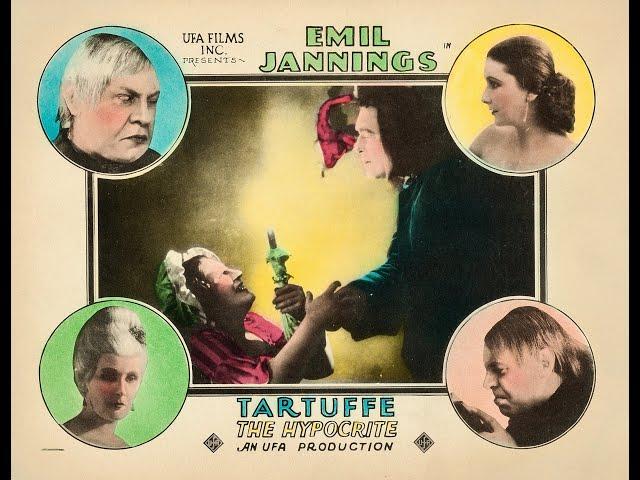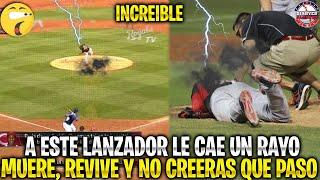
Emil Jannings in F. W. Murnau's "Tartuffe" (1925)
This fable begins with the story of a wealthy, elderly man being given a slow premature death by his money-grubbing hypocritical housekeeper, Seine Haushälteri (Rosa Valetti).
She has convinced the man that his grandson is evil and should be disinherited because he is an actor, and she's fooled him into making her his beneficiary. While she navigates her plan, she is slowly poisoning him.
Along comes his disowned grandson (Sein Enke (André Mattoni), an actor, who sees through the housekeeper's plans. He's come to say hello, but the old man shuns him, and he is sent away, but only after discovering that the housekeeper has used poison on his grandfather. It appears the housekeeper has won.
We see the young grandson being booted out of the house. Then he walks up to the camera and looks at us, the audience, smiling, assuring us that the matter is not finished, and that he will be back to avenge his grandfather.
The grandson returns disguised as a traveling cinema worker, who, upon getting into his grandfather's house, proceeds to show them the story of Herr Tartuff.
Rich landowner Herr Orgon (Werner Krauss) brings his new friend and religious fanatic Tartuffe (Emil Jannings) home, much to the dismay of Orgon's wife, Frau Elmire (Lil Dagover). Tartuffe is an absolute monster. After Orgon's wife spurns Tartuffe's sexual advances, she sets out to prove to Orgon that Tartuffe is an imposter who is seeking to inherit Orgon's vast estate.
A 1925 German expressionist silent comedy-drama film (a/k/a "Herr Tartüff") directed by F. W. Murnau, produced by Erich Pommer, written by Carl Mayer, based on Molière's original play, cinematography by Karl W. Freund (as Carl Freund), starring Emil Jannings, Lil Dagover, Werner Krauss, Hermann Picha, Rosa Valetti, André Mattoni, and Lucie Höflich.
Camilla Horn served as Lil Dagover's foot double in this film. This small role effectively launched her lengthy acting career, as she was noticed by director F.W. Murnau and cast as the lead actress in his film, "Faust" (1926).
It was shot at the Tempelhof Studios in Berlin for UFA and released in 1926. Filmed on Agfa and Kodak stock, using a Pathé-Industriel camera. Set design and costumes were by Robert Herlth and Walter Röhrig.
Based on the play 'Tartuffe', the film retains the basic plot, but Murnau and Mayer pared down Molière's play, eliminating most of the secondary characters and concentrating on the triangle of Orgon, Elmire and Tartuffe. They also introduced a framing device, whereby the story of Tartuffe becomes a film-within-a-film, shown by a young actor as a device to warn his grandfather about his unctuous but evil housekeeper.
When first performed at Versailles in 1664 his play 'Tartuffe' landed Moliere in all sorts of trouble due to its depiction of impiety and religious hypocrisy. Apparently the Archbishop of Paris threatened anyone with excommunication who performed, watched or even read it! It was finally staged with great success in 1669 in the five act version we know today.
At the time, Directors were simply terrified to try new techniques, but not Murnau. There is a shocking scene involving the first exchanges between Tartuffe and Elmire. She is in the midst of demanding him to leave, when the camera droops down from her face, and lingers on her cleavage, which is slightly visible due to the way she is looking down upon Tartuffe. All is seen from Tartuffe's point of view, and this happens a number of times. Surprisingly saucy given it's age.
In retrospective reviews, critics commented on the film's mise-en-scene and praised the performances. Several critics noted the rarity of a comedy directed by Murnau, who was famous for the expressionist dramas. Its humorous storyline and happy ending has rendered it a minor work in Murnau's filmography and has led film critic Jonathan Rosenbaum to call it "underrated."
A minor Murnau work, sandwiched in between two of his masterpieces, "Der Letzte Mann" (1924) und "Faust" (1926), but remains essential viewing. This may be a transitional film for Herr Murnau but it's still an imaginative approach to the Molière play wherein religious criticism and moral weaknesses and other human sins are shown openly and straightforwardly.
Inspired by the classic seventeenth century comedy by playwright Herr Molière, the film depicts one kind of masquerade inside another one, a film within-a-film. The frame story is shot realistically, with Freund and Murnau consistently emphasizing depth through movement from background to foreground, and by opening and closing doors in such a way that they are literally in the spectator's face. Appropriately, the rococo sets are shot in a decadent but luminous style for the old story while a dark and gloomier manner prevails for the modern scenes. The look of the film is impressive, with a lavish set to work with, striking lighting techniques, and a few bold camera angles. Not one of Murnau's best, but any Murnau film is worth seeing.
She has convinced the man that his grandson is evil and should be disinherited because he is an actor, and she's fooled him into making her his beneficiary. While she navigates her plan, she is slowly poisoning him.
Along comes his disowned grandson (Sein Enke (André Mattoni), an actor, who sees through the housekeeper's plans. He's come to say hello, but the old man shuns him, and he is sent away, but only after discovering that the housekeeper has used poison on his grandfather. It appears the housekeeper has won.
We see the young grandson being booted out of the house. Then he walks up to the camera and looks at us, the audience, smiling, assuring us that the matter is not finished, and that he will be back to avenge his grandfather.
The grandson returns disguised as a traveling cinema worker, who, upon getting into his grandfather's house, proceeds to show them the story of Herr Tartuff.
Rich landowner Herr Orgon (Werner Krauss) brings his new friend and religious fanatic Tartuffe (Emil Jannings) home, much to the dismay of Orgon's wife, Frau Elmire (Lil Dagover). Tartuffe is an absolute monster. After Orgon's wife spurns Tartuffe's sexual advances, she sets out to prove to Orgon that Tartuffe is an imposter who is seeking to inherit Orgon's vast estate.
A 1925 German expressionist silent comedy-drama film (a/k/a "Herr Tartüff") directed by F. W. Murnau, produced by Erich Pommer, written by Carl Mayer, based on Molière's original play, cinematography by Karl W. Freund (as Carl Freund), starring Emil Jannings, Lil Dagover, Werner Krauss, Hermann Picha, Rosa Valetti, André Mattoni, and Lucie Höflich.
Camilla Horn served as Lil Dagover's foot double in this film. This small role effectively launched her lengthy acting career, as she was noticed by director F.W. Murnau and cast as the lead actress in his film, "Faust" (1926).
It was shot at the Tempelhof Studios in Berlin for UFA and released in 1926. Filmed on Agfa and Kodak stock, using a Pathé-Industriel camera. Set design and costumes were by Robert Herlth and Walter Röhrig.
Based on the play 'Tartuffe', the film retains the basic plot, but Murnau and Mayer pared down Molière's play, eliminating most of the secondary characters and concentrating on the triangle of Orgon, Elmire and Tartuffe. They also introduced a framing device, whereby the story of Tartuffe becomes a film-within-a-film, shown by a young actor as a device to warn his grandfather about his unctuous but evil housekeeper.
When first performed at Versailles in 1664 his play 'Tartuffe' landed Moliere in all sorts of trouble due to its depiction of impiety and religious hypocrisy. Apparently the Archbishop of Paris threatened anyone with excommunication who performed, watched or even read it! It was finally staged with great success in 1669 in the five act version we know today.
At the time, Directors were simply terrified to try new techniques, but not Murnau. There is a shocking scene involving the first exchanges between Tartuffe and Elmire. She is in the midst of demanding him to leave, when the camera droops down from her face, and lingers on her cleavage, which is slightly visible due to the way she is looking down upon Tartuffe. All is seen from Tartuffe's point of view, and this happens a number of times. Surprisingly saucy given it's age.
In retrospective reviews, critics commented on the film's mise-en-scene and praised the performances. Several critics noted the rarity of a comedy directed by Murnau, who was famous for the expressionist dramas. Its humorous storyline and happy ending has rendered it a minor work in Murnau's filmography and has led film critic Jonathan Rosenbaum to call it "underrated."
A minor Murnau work, sandwiched in between two of his masterpieces, "Der Letzte Mann" (1924) und "Faust" (1926), but remains essential viewing. This may be a transitional film for Herr Murnau but it's still an imaginative approach to the Molière play wherein religious criticism and moral weaknesses and other human sins are shown openly and straightforwardly.
Inspired by the classic seventeenth century comedy by playwright Herr Molière, the film depicts one kind of masquerade inside another one, a film within-a-film. The frame story is shot realistically, with Freund and Murnau consistently emphasizing depth through movement from background to foreground, and by opening and closing doors in such a way that they are literally in the spectator's face. Appropriately, the rococo sets are shot in a decadent but luminous style for the old story while a dark and gloomier manner prevails for the modern scenes. The look of the film is impressive, with a lavish set to work with, striking lighting techniques, and a few bold camera angles. Not one of Murnau's best, but any Murnau film is worth seeing.
Тэги:
#Emil_Jannings #Lil_Dagover #Werner_Krauss #Hermann_Picha #Rosa_Valetti #André_Mattoni #Camilla_Horn #Lucie_Höflich #1926_films #1920s_German_films #Works_based_on_Tartuffe #German_Expressionist_films #Films_produced_by_Erich_Pommer #Films_based_on_works_by_Molière #German_black-and-white_films #Films_directed_by_F._W._Murnau #Silent_German_comedy-drama_films #comedy-drama_films #F.W._Murnau #Erich_Pommer #Giuseppe_Becce #Karl_Freund #Robert_Herlth #Walter_Röhrig #MurnauКомментарии:
Emil Jannings in F. W. Murnau's "Tartuffe" (1925)
Donald P. Borchers
Камеди клаб от лукашенко)
Сергей Ведута
PRESIDEN SOEKARNO. | #historytellingJASMERAH
Nessie Judge
1000s men tell what fragrances drive them crazy on women TOP 20 DESIGNER & NICHE.
Clémence CC Fragrance
1000s women tell what fragrances drive them crazy on men TOP 20 DESIGNER & NICHE.
Clémence CC Fragrance
How To Make Your Galaxy S8 Faster & Improve Your Battery Life - YouTube Tech Guy
The YouTube Tech Guy


























